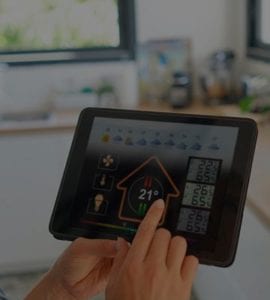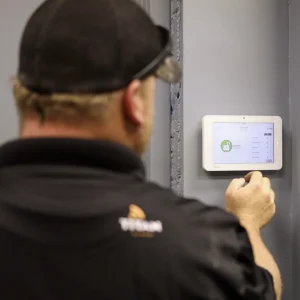What Powers My Home Security System?
05/18/2017

If you’ve installed a home security system to protect your home, you might not have given much thought to how it actually works. Today’s systems consist of a series of integrated devices that work together seamlessly to deter and detect intruders and trigger alarms. They also offer monitoring capabilities to ensure the prompt dispatching of first responders when an emergency occurs.
The main components that power your home security system include:
-
Control Panel:
The control panel of a home control security system serves as its main hub or “nerve center.” It’s where you can arm and disarm the system, control its various functions and communicate with the monitoring service.
-
Motion Sensors:
Motion sensors detect movement — such as when an intruder attempts to gain access to your home — and notifies the control panel.
-
Window and Door Sensors:
Many security systems feature sensors on the windows and doors that notify the control panel if someone tries to break in.
-
Cameras:
Surveillance cameras provide views of your property so that you and the monitoring service can spot potential signs of trouble.
-
Alarms/detectors:
Fire and burglar alarms, as well as smoke and carbon monoxide detectors send a notification to the control panel and deliver audible alerts to make residents aware of an emergency.
-
Monitoring Service:
The best security systems include monitoring by a professional monitoring service that receives signals from the control panel and assesses the extent of the emergency.
How Security Systems Are Powered?
Of course, it takes a lot of “juice” to run the various security system devices. The system operates via low-voltage electrical power supplied by a transformer installed in a wall of your home — it’s not wired directly into your home’s electrical system. The security system also includes backup batteries located inside the control panel that ensure continuous operation in the event of a power outage.

What Is the Delivery Method for the Electrical Power?
Traditional security systems are hardwired, meaning that the sensors, cameras and other devices are connected to the transformer and control panel with electrical cabling. However, technological advancements have led to the development of wireless devices that operate via self-contained batteries. These devices are programmed to send a signal to the monitoring service when the batteries run low.
Communication between the control panel and the central monitoring service can occur via landline telephone, wireless cellular or Internet technology. The problem with the former method is that as severe storm could knock down the power lines or a burglar could cut the phone line running into your home, which will prevent timely notification of the monitoring service. That’s why many homeowners are opting for a wireless security system set-up.
Contact Titan Alarm, Inc. for Reliable Home Security System Installation in Phoenix
Titan Alarm has been providing effective, affordable home security solutions for residents in the Phoenix, AZ area for more than a decade. We can design and install a state-of-the-art security system you can count on to keep your family and property safe. Contact us to schedule a free in-home security consultation today!



